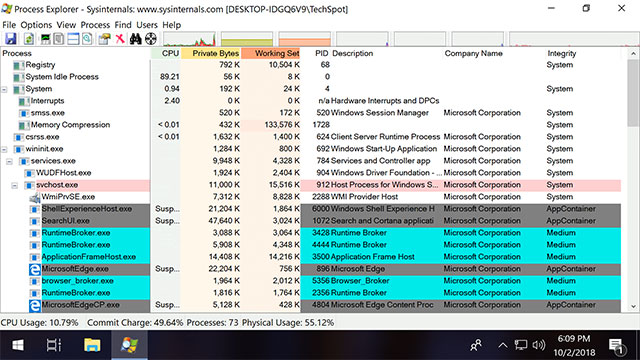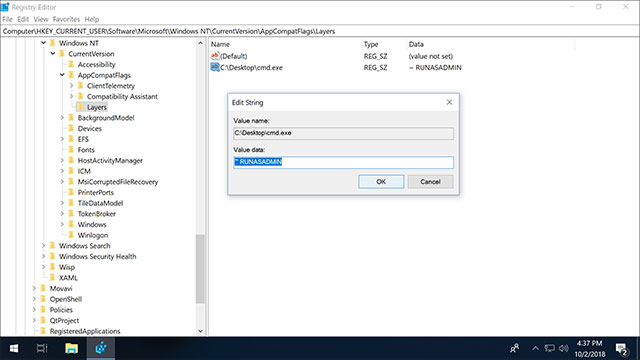What does running software with administrative rights mean?
The familiar readers of TipsMake.com are probably no stranger to opening software with administrative rights, something that you probably still do everyday. But let's learn more about why to do so and when you ask the OS to run the software with administrative rights, what happens to Windows?
Thanks to switching from Windows XP to Vista, you were introduced to User Account Control (UAC) and Mandatory Intgrity Control (MIC). The security feature in this OS will open a notification when software changes the system and is also the key when the software needs to gain access.

Notice of the right to change the system for the software
When logging in Windows, the account will be given a code that contains identifying information including user groups and priorities such as reading, writing, and executing. In the information that has an integrity level (integrity level) used by OS to identify the file, whether the registry key is secure and inform the user when installing or separating the process from unnecessary access file system.

User Account Control
The Windows Mandatory Integrity Control mechanism (MIC) has at least 6 integrity levels: unreliable, low, medium, high, system and reliable.
By default, the average user will have an average, which is the highest level possible to create the process when opening the executable file without upgrading permissions with the administrator's password.
When right-clicking and selecting 'Run as administrator', this process will start with administrator privileges, giving higher permissions to features that may require deeper access to files in Windows.
Integrity levels in Windows:
- Unreliable: anonymous processes.
- Low: commonly used for web software like browsers.
- Medium: for normal users, most objects.
- High: access rights at the administrative level, often need to upgrade.
- System: for core and core Windows services.
- Reliable: for system components, Windows Updates.
The process that begins when opening an EXE file with an average Windows account will have that level of integrity, unless the executable file is set to a lower level or the developer encourages a low level of access, avoiding the The installation requires a high level to prevent unauthenticated code (malware) from gaining root access.

The processes run on the computer
Minimum permissions are applied to Windows admin accounts, there will be either standard or administrative rights after logging in, using standard / medium access when possible, instead of using a high level than.
Although Microsoft recommends that you do not run the software with administrative rights and give them high access without a reasonable reason, there must be new data added to Program Files to install the new software, ie UAC must be turned on, while software like AutoHotkey often needs to be upgraded to work properly.
If you do not know how to open the software using administrative rights, please refer to the article 4 ways to run the software using administrative rights in Windows. Although Microsoft 's philosophy is to limit as many rights as possible, it is not recommended to set up software to run with administrative rights. But sometimes this is useful when the software always needs permission, and you don't want to use it every time you open it.
- How to launch Admin rights application for User account in Windows?
- Activate Standard User to run the program under Admin without a password
How to force the software to always run with administrative rights
Always run as administrator via shortcut: Right-click the shortcut> select Shortcut tab> Advanced > Select the Run as administrator dialog box.
You can create a shortcut by right-clicking on the EXE file, if you copy the shortcut to C: UsersTechSpotAppDataRoamingMicrosoftWindowsStart MenuProgramsStartup, the software will automatically open with Windows when you log in.
Always run with administrative rights through Compatibility Properties : right-click EXE> Properties> select Compatibility tab> select the Run this program dialog box as an administrator.
Always run as administrator privileges through the Registry Editor:
- Go to HKEY_CURRENT_USERSoftwareMicrosoftWindows NTCurrentVersionAppCompatFlagsLayers
- Without Layers, right click on AppCompatFlags and add a new key named Layers.
- Right-click on the Layers (in the folder or control panel) and create String Value.
- Name the value according to the full path of the EXE file.
- Set the value data to ~ RUNASADMIN.

Always run with administrative rights through the Registry Editor
A few other tricks
Third-party software such as MicEnum will create a Windows file / directory list and their integrity level, including the ability to set a new integrity level, browse as directory and registry.
Process Explorer can also display integrity when right-clicking on horizontal walls with CPU, Private Bytes . and opening Properties.
When installing a new Windows version, the first user will have an administrator account, then only at the standard level. By default, the available admin account will be disabled. You can turn it back on to open this account as soon as you log on to Windows by entering the following line into the Command Prompt (use 'no' to disable it). Net user administrator / active: yes.
Microsoft also has utilities like Elevation PowerToys or PsExec to get administrative rights.
See more:
- Techniques for decentralizing Window administration
- How to open the pin application on the Taskbar Administrator with Windows 10
- Losing Admin permissions on Windows 10 / 8.1, this is a fix
You should read it
- The chat group on Facebook Messenger adds administrative rights
- How to open CMD with Administrator rights on Win 10
- How to Take Steps to Protect Human Rights
- How to run File Explorer with administrative rights in Windows 11
- How to open Notepad with admin rights
- How to set up always opening applications with admin rights on Windows 11
- Summary of basic cmd commands and how to open Administrator rights
- How to open the hosts file with Admin rights - Apply to open the file system
May be interested
- Lost Admin rights on Windows 10, this is how to fix it
 for some reason, your windows 10 computer has lost admin rights. every time you open an application on the screen, you receive an error message. so how to restore lost admin rights, please refer to the article below,
for some reason, your windows 10 computer has lost admin rights. every time you open an application on the screen, you receive an error message. so how to restore lost admin rights, please refer to the article below, - How to run File Explorer with administrative rights in Windows 11
 sometimes you will need to run file explorer with elevated privileges to perform a certain task as an administrator of the system.
sometimes you will need to run file explorer with elevated privileges to perform a certain task as an administrator of the system. - How to Create an Administrative Installation Point for Installing Entrust Security Provider for Windows
 an administrative installation point is a method of installing software to multiple computers on a network using microsoft's install engine. this is advantageous to administrators of a large group of users. it allows the administrator to...
an administrative installation point is a method of installing software to multiple computers on a network using microsoft's install engine. this is advantageous to administrators of a large group of users. it allows the administrator to... - How to get admin rights on Windows
 perhaps you tried to access something and were told that you don't have admin rights. today's article will show you how to get admin rights on windows 10.
perhaps you tried to access something and were told that you don't have admin rights. today's article will show you how to get admin rights on windows 10. - How to open Notepad with admin rights
 the 'notepad access denied' error usually occurs when you try to modify the system file from a standard user account on the pc. you will need to open notepad with admin rights to fix the error. there are many ways to run notepad with admin rights.
the 'notepad access denied' error usually occurs when you try to modify the system file from a standard user account on the pc. you will need to open notepad with admin rights to fix the error. there are many ways to run notepad with admin rights. - How to reset all user rights to default in Windows 11
 having problems with apps or programs that don't run properly on your windows computer? reset windows permissions may be the solution you need.
having problems with apps or programs that don't run properly on your windows computer? reset windows permissions may be the solution you need. - How to set up always opening applications with admin rights on Windows 11
 similar to other versions of windows, on windows 11, you will sometimes need to launch programs and applications with elevated privileges to perform a certain task as an administrator (admin) of windows. system.
similar to other versions of windows, on windows 11, you will sometimes need to launch programs and applications with elevated privileges to perform a certain task as an administrator (admin) of windows. system. - How to Uninstall AVG
 this wikihow teaches you how to uninstall avg products from your pc or mac. restart your pc. avg recommends restarting before you try to install to ensure that there are no administrative tasks running in the background.https://support.a...
this wikihow teaches you how to uninstall avg products from your pc or mac. restart your pc. avg recommends restarting before you try to install to ensure that there are no administrative tasks running in the background.https://support.a... - How to grant Admin rights to a User in Win 10
 how to grant admin rights to a user in windows 10. to work effectively and ensure data on windows 10 computers, we often divide them into different users if the computer has 2 or more users. if you do not know how to grant admin rights to users in windows 10, please refer to the following tutorial!
how to grant admin rights to a user in windows 10. to work effectively and ensure data on windows 10 computers, we often divide them into different users if the computer has 2 or more users. if you do not know how to grant admin rights to users in windows 10, please refer to the following tutorial! - How to fix the error has stopped working when running the software
 during the process of using the computer, you have probably encountered the has stop working error when running an application. this is a quite annoying error and there are many causes, possibly due to software missing files, virus or malware destruction ... etc.
during the process of using the computer, you have probably encountered the has stop working error when running an application. this is a quite annoying error and there are many causes, possibly due to software missing files, virus or malware destruction ... etc.










 What is firmware? How is Firmware different from Software?
What is firmware? How is Firmware different from Software? Cmstp command in Windows
Cmstp command in Windows Practice typing 10 fingers, typing fast with Mario Teaches Typing game
Practice typing 10 fingers, typing fast with Mario Teaches Typing game Pros and cons of Google Chrome
Pros and cons of Google Chrome Prncnfg command in Windows
Prncnfg command in Windows Choice command in Windows
Choice command in Windows